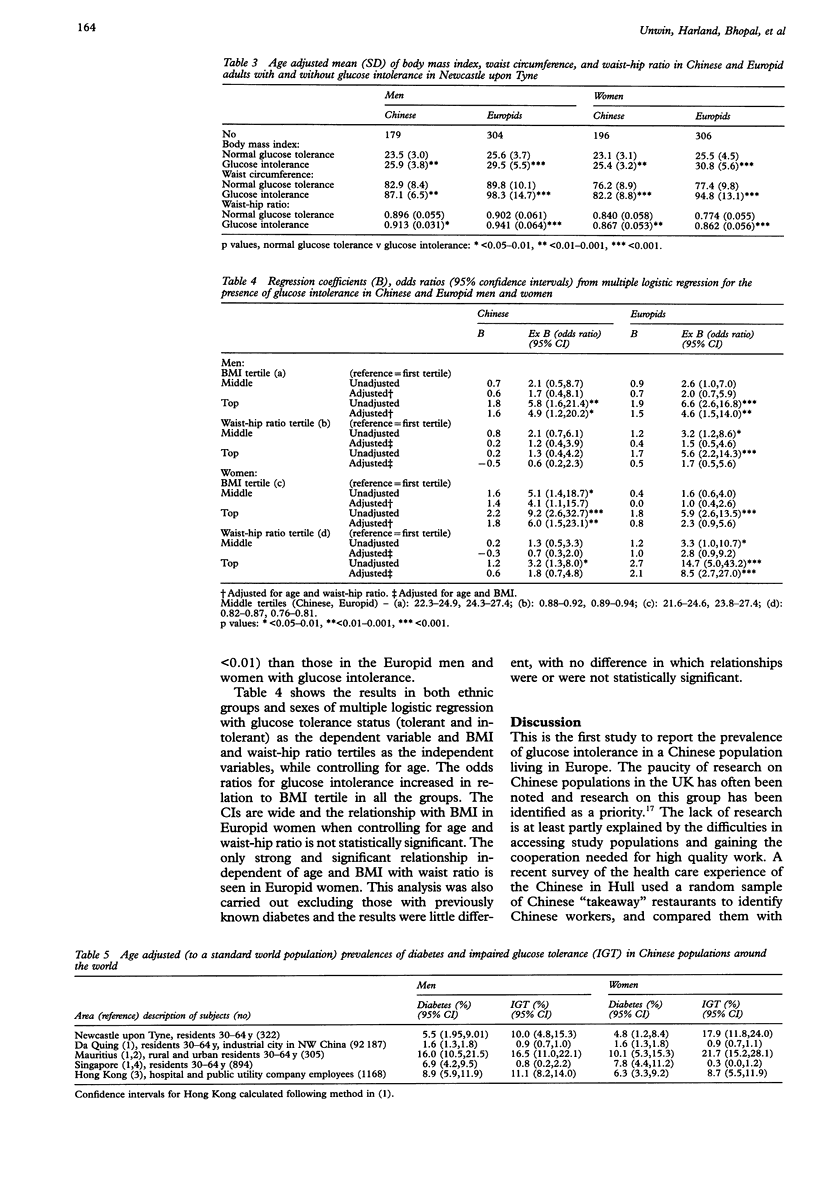Abstract
OBJECTIVE: To compare the prevalence of glucose intolerance (impaired glucose tolerance and diabetes), and its relationship to body mass index (BMI) and waist-hip ratio in Chinese and Europid adults. DESIGN: This was a cross sectional study. SETTING: Newcastle upon Tyne. SUBJECTS: These comprised Chinese and Europid men and women, aged 25-64 years, and resident in Newcastle upon Tyne, UK. MAIN OUTCOME MEASURES: Two hour post load plasma glucose concentration, BMI, waist circumference, and waist-hip ratio. METHODS: Population based samples of Chinese and European adults were recruited. Each subject had a standard WHO oral glucose tolerance test. RESULTS: Complete data were available for 375 Chinese and 610 Europid subjects. The age adjusted prevalences of glucose intolerance in Chinese and Europid men were 13.0% (p = 0.04). Mean BMIs were lower in Chinese men (23.8 v 26.1) and women (23.5 v 26.1) than in the Europids (p values < 0.001), as were waist circumferences (men, 83.3 cm v 90.8, p < 0.001; women, 77.3 cm v 79.2, p < 0.05). Mean waist-hip ratios were lower in Chinese men (0.90 v 0.91, p = 0.02) but higher in Chinese women (0.84 v 0.78, p < 0.001) compared with Europids. In both Chinese and Europid adults, higher BMI, waist circumference, and waist-hip ratio were associated with glucose intolerance. CONCLUSIONS: The prevalence of glucose intolerance in Chinese men and women, despite lower BMIs, is similar to or higher than that in local Europid men and women and intermediate between levels found in China and those in Mauritius. It is suggested that an increase in mean BMI to the levels in the Europid population will be associated with a substantial increase in glucose intolerance in Chinese people.
Full text
PDF






Selected References
These references are in PubMed. This may not be the complete list of references from this article.
- Burrin J. M., Price C. P. Measurement of blood glucose. Ann Clin Biochem. 1985 Jul;22(Pt 4):327–342. doi: 10.1177/000456328502200401. [DOI] [PubMed] [Google Scholar]
- Chaturvedi N., McKeigue P. M., Marmot M. G. Relationship of glucose intolerance to coronary risk in Afro-Caribbeans compared with Europeans. Diabetologia. 1994 Aug;37(8):765–772. doi: 10.1007/BF00404333. [DOI] [PubMed] [Google Scholar]
- Cockram C. S., Woo J., Lau E., Chan J. C., Chan A. Y., Lau J., Swaminathan R., Donnan S. P. The prevalence of diabetes mellitus and impaired glucose tolerance among Hong Kong Chinese adults of working age. Diabetes Res Clin Pract. 1993 Jul;21(1):67–73. doi: 10.1016/0168-8227(93)90099-q. [DOI] [PubMed] [Google Scholar]
- Coldman A. J., Braun T., Gallagher R. P. The classification of ethnic status using name information. J Epidemiol Community Health. 1988 Dec;42(4):390–395. doi: 10.1136/jech.42.4.390. [DOI] [PMC free article] [PubMed] [Google Scholar]
- Dowse G. K., Gareeboo H., Zimmet P. Z., Alberti K. G., Tuomilehto J., Fareed D., Brissonnette L. G., Finch C. F. High prevalence of NIDDM and impaired glucose tolerance in Indian, Creole, and Chinese Mauritians. Mauritius Noncommunicable Disease Study Group. Diabetes. 1990 Mar;39(3):390–396. doi: 10.2337/diab.39.3.390. [DOI] [PubMed] [Google Scholar]
- Dowse G. K., Qin H., Collins V. R., Zimmet P. Z., Alberti K. G., Gareeboo H. Determinants of estimated insulin resistance and beta-cell function in Indian, Creole and Chinese Mauritians. The Mauritius NCD Study Group. Diabetes Res Clin Pract. 1990 Nov-Dec;10(3):265–279. doi: 10.1016/0168-8227(90)90070-a. [DOI] [PubMed] [Google Scholar]
- Dowse G. K., Zimmet P. Z., King H. Relationship between prevalence of impaired glucose tolerance and NIDDM in a population. Diabetes Care. 1991 Nov;14(11):968–974. doi: 10.2337/diacare.14.11.968. [DOI] [PubMed] [Google Scholar]
- Hamman R. F. Genetic and environmental determinants of non-insulin-dependent diabetes mellitus (NIDDM). Diabetes Metab Rev. 1992 Dec;8(4):287–338. doi: 10.1002/dmr.5610080402. [DOI] [PubMed] [Google Scholar]
- Harris M. I. Undiagnosed NIDDM: clinical and public health issues. Diabetes Care. 1993 Apr;16(4):642–652. doi: 10.2337/diacare.16.4.642. [DOI] [PubMed] [Google Scholar]
- Işcan M. Y. Assessment of race from the pelvis. Am J Phys Anthropol. 1983 Oct;62(2):205–208. doi: 10.1002/ajpa.1330620210. [DOI] [PubMed] [Google Scholar]
- King H., Rewers M. Global estimates for prevalence of diabetes mellitus and impaired glucose tolerance in adults. WHO Ad Hoc Diabetes Reporting Group. Diabetes Care. 1993 Jan;16(1):157–177. doi: 10.2337/diacare.16.1.157. [DOI] [PubMed] [Google Scholar]
- Nicoll A., Bassett K., Ulijaszek S. J. What's in a name? Accuracy of using surnames and forenames in ascribing Asian ethnic identity in English populations. J Epidemiol Community Health. 1986 Dec;40(4):364–368. doi: 10.1136/jech.40.4.364. [DOI] [PMC free article] [PubMed] [Google Scholar]
- Stern M. P., Morales P. A., Valdez R. A., Monterrosa A., Haffner S. M., Mitchell B. D., Hazuda H. P. Predicting diabetes. Moving beyond impaired glucose tolerance. Diabetes. 1993 May;42(5):706–714. doi: 10.2337/diab.42.5.706. [DOI] [PubMed] [Google Scholar]
- Watt I. S., Howel D., Lo L. The health care experience and health behaviour of the Chinese: a survey based in Hull. J Public Health Med. 1993 Jun;15(2):129–136. [PubMed] [Google Scholar]


